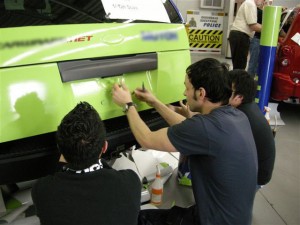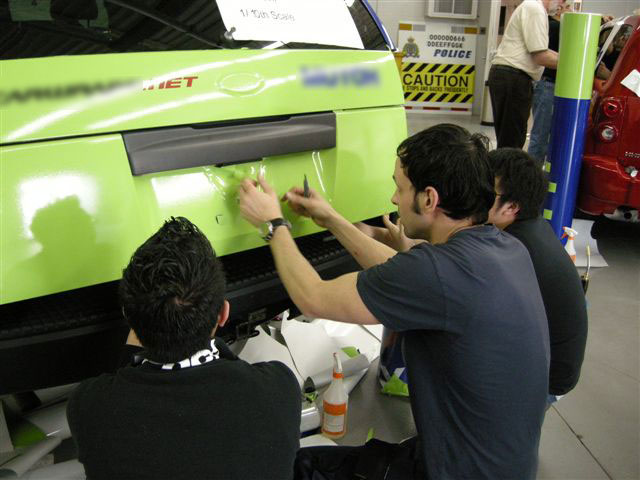Justin Pate is an Avery Specialist Installer and a 3M certified graphics installer who worked out of the New York City area for over 11 years and now, for the past three years, out of Amsterdam, the Netherlands. Justin has installed graphics on buildings, windows, floors, walls and glass but full coverage vehicle wraps have become his specialty.
Over his 14-year career, Justin has wrapped over 2,500 vehicles, a majority of them by himself. A combination of the fast pace of New York City and being an all-around athlete helped him create a method for wrapping vehicles he calls UGIS: Universal Graphic Installation System. Using this system, Justin can comfortably wrap almost any vehicle by himself in under 4 hours and even some vehicles, like cargo vans, in two hours.
SignIndustry.com caught up with Pate to discuss his passion, his wrapping system, and his advice for installers looking to make a go of it in the wrapping business.
SignIndustry.com:
Why are you so passionate about training people on how to do wraps?
Pate:
There are several reasons why I’m so passionate about training people. First off, I’ve been wrapping cars for 15 years now and its never gotten old. Every install feels fresh and exciting and that carries over to instructing. I feel that its a great way to make a living-it pays well, you have a finished product at the end of the day, and each vehicle wrap presents new challenges. I feel that if I can help someone get up to speed and installing high quality wraps then it helps the whole industry. Every wrap out there is a reflection of all installers. The better everyone gets the bigger the industry becomes which is good for everyone.
SignIndustry.com:
Of the thousands of wraps that you’ve done, which one is your favorite and why?
Pate:
There are many favorites for different reasons but I think if I had to single one out it would be a fleet job I did for Costar a few years ago. I was hired by Carwraps to wrap 90 Prius’ for CoStar down in the D.C area. The kicker for the job was that they had to be done in 30 days. With a little preparation and foresight, all the vehicles were arranged under one roof and all the graphics printed ahead of time. This meant that Shad Interligi, from Real Hit Media, and I could just put our heads down and wrap.
What I found most interesting was that one-day we would just wrap hoods, the next day it would be passenger sides. It was very singular, focused and, at times, surreal. In many ways this job took me to another level because I really honed my Speedwrapping system, which is wrapping with the highest quality and durability at maximum efficiency. I’m proud to say that just the two of us finished all the vehicles in 22 days and, four years later, I haven’t had one complaint about failure.
SignIndustry.com:
Any disasters from your early days that might hold valuable lessons?
Pate:
The biggest disaster came early on in my career. I wrapped two buses in the dead of winter-one for 112 and the other for Luke from 2 Live Crew. My client gave me removable film for buses that were hitting the road for two- to three-month tours in the dead of winter. I brought up the possibility that the film might not stick but was told to put it on. The next day my client got a call from the bus drivers saying that literally half the graphics flew off during the night. My client then had to reprint with the right film and fly me to Augusta, Ga. and then to Daytona, Fla., where I fixed the buses. It was an invaluable lesson for me in that using the right film is key. Many people try to go cheap on the front end but it rarely pays off. After this, I educated my clients on what films to use for what circumstances, which over the years, made them money and my life a lot easier.
SignIndustry.com:
Talk a little about what UGIS is and what are the benefits.
Pate:
UGIS stands for Universal Graphics Installation System. I developed this over the years from compiling everything that I’ve learned from working both in the U.S. and in Europe. Essentially, it’s the common denominator for what a wrapper must do in order to install professional level graphics. It’s made up of three modules: The Basics (squeegeeing, cutting and heating), The Method (glass, triangles and hinges) and Five Good Habits.
There are many benefits of using UGIS. By having a system, each car becomes the same, thus significantly reducing mistakes and install times. When installers use the same system, they sp eak a common language, which makes communication and problem solving much easier. Lastly, having an easy-to-learn system like UGIS makes learning the art of graphic installations instantly accessible. It allows me to show newcomers that wrapping can be fun and exciting which, for the learning process, is half the battle.
eak a common language, which makes communication and problem solving much easier. Lastly, having an easy-to-learn system like UGIS makes learning the art of graphic installations instantly accessible. It allows me to show newcomers that wrapping can be fun and exciting which, for the learning process, is half the battle.
SignIndustry.com:
Where do you stand on wet vs. dry installation debate and why?
Pate:
I never do wet installations on vehicles. Wet installs are to be done on films that do not have air-egress and repositionable technology. Water will stay inside the channels of the adhesive, which is a problem in terms of achieving proper adhesion. Also, wet installs only work on flat surfaces and, other than flat trucks with no rivets, all vehicles are curved. That said, if the film has no air egress then wet installs can be done on a moderately curved roof or hood.
SignIndustry.com:
Where are the biggest opportunities in the wrap business today?
Pate:
I think the opportunities for the wrap business get more and more varied as new films and technologies come on the market. With new super conformable films like Avery MPI 1005 Supercast and Supercast overlaminates, what can be wrapped, like helmets and extreme vehicles, becomes possible. Also, there are now films for almost any surface, like concrete, so once an installer gets professional level skills, they can work in any medium, which is great both in terms of money and demand.
SignIndustry.com:
How has the vinyl installation business changed over the years?
Pate:
The wrap business has changed a lot over the years mainly in terms of growth. The film has gotten better to work with, the printers have gotten better and more accessible in terms of price and there are more installers then ever before.
I do think the business is going through some growing pains, partially from the recession. What I mean is that there have been a lot of people really selling wraps both for printing and install essentially at cost. I understand that a lot of people new to the industry just want to get their foot in the door or people think short-term but by steeply undercutting the average price for a wrap in a regional market, it really hurts everyone both short and long term.
I think it’s very important that printers and installers see themselves as part of a big community. By staying within a certain price range then quality and reliability become the standard for our industry, which will make advertisers spend their money on wraps, which they should. It’s the most economical and effective way for people to advertise.
SignIndustry.com:
What’s the toughest part of the wrap business?
Pate:
I think it’s the learning curve. It takes a long time to achieve the proper skills to put the film on with a professional level quality. Yes, you can learn on your own but the film is expensive and the vehicles cannot be cut on, which happens a lot with beginners. Taking a workshop from a good training program-like Mutoh’s School of Wrap-or watching a DVD, like my own, can really take months off of the learning process. Also, I think it takes a certain personality to be an installer. It’s a demanding job-it’s physically as well as mentally challenging in terms of focus and problem solving. Being able to find the flow on a vehicle day in and day out is tough to achieve but if you can wrapping becomes a lot of fun.
SignIndustry.com:
Any advice for launching a wrapping business?
Pate:
I think the biggest key is to see that everything is connected. Creating good designs that please the clients and are not overly complicated to install is a key starting point. A good production team that labels the panels, cuts them properly and provides layouts to the installer saves tremendous amounts of film and time. Owners who buy quality film may spend more up front but will save money by lowering install times and having fewer failures. Skimp on film, make a bad design or use poor install technique creates exponential problems in the wrap business.
SignIndustry.com:
Andy other advice or tips that you can share?
Pate:
Some days are going to be good. Others are going to be long. It’s the nature of the business. The key is to do it right every time. I have made more money and have kept clients for the long haul because I show up on time, I problem solve with the client in mind, I work hard and I act like a professional. Being consistently good all the time is the recipe to security and profits.
You can visit Justin online at www.justinpate.net and www.learntowrapcars.com.
As seen on signindustry.com.



